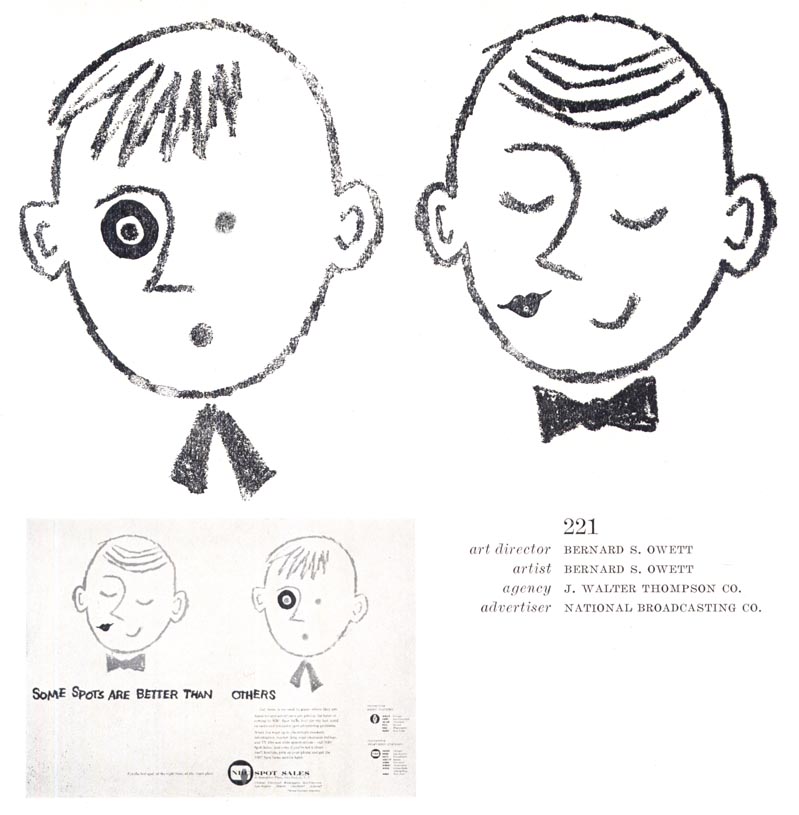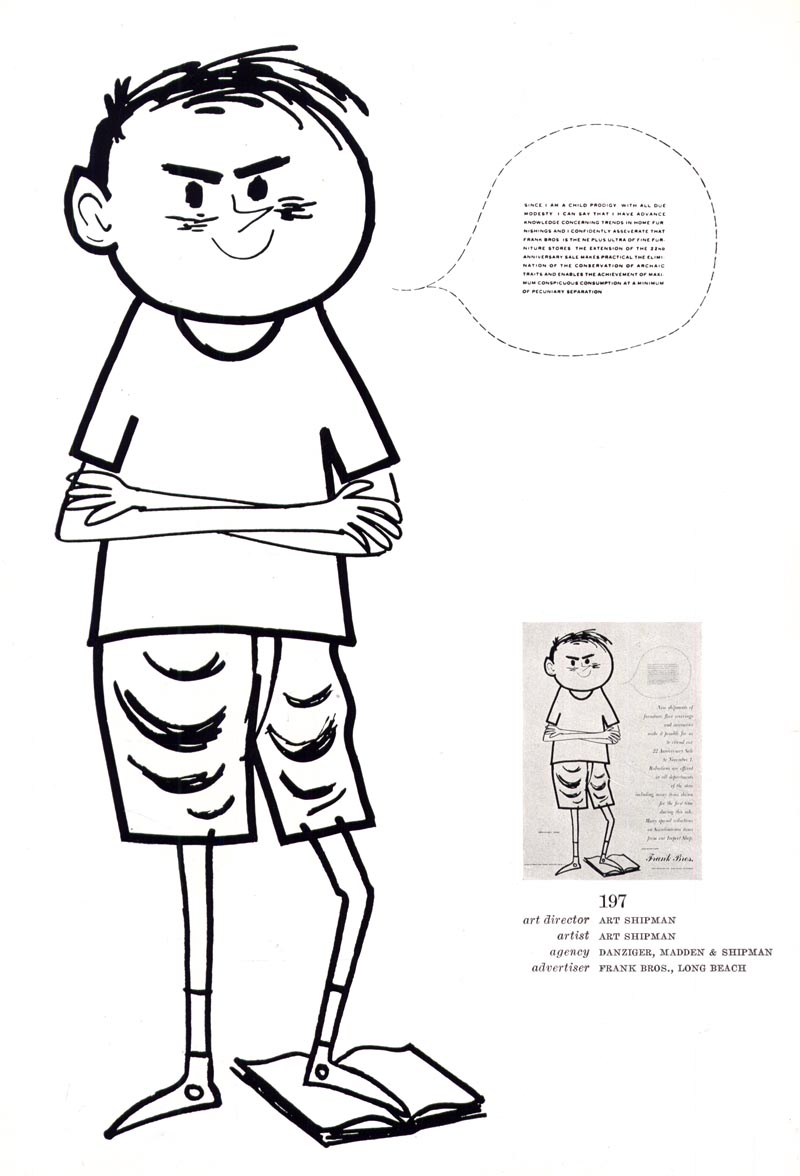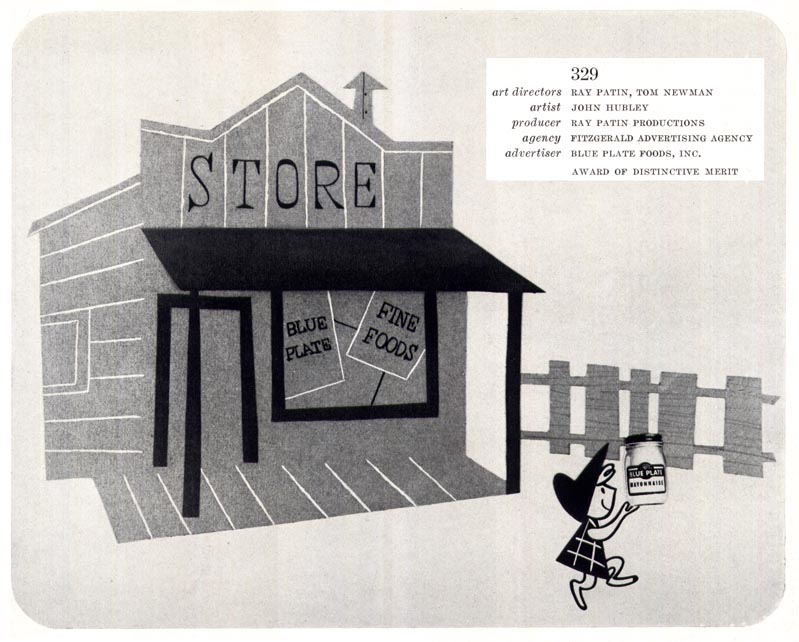Two extremely important points were raised by commenters: that beyond the niche of cartooning, modern abstract (and abstract expressionist) art must surely have impacted how all commercial art was evolving...

... and that television (especially with the technical issues of those early broadcasts) required art with a greater degree of clarity and simplicity to ensure audiences could clearly see the visuals being presented and quickly grasp the message being conveyed.

All of today's images are from the 1952 New York Art Directors Annual. Based on the majority of pieces included in that volume, one quickly sees that the selection committee was drawn to images that emphasized those qualities.

Gone are the fully-rendered, painterly pieces, realistic representations, and traditional subjects.

The vast majority of images in that year's show would bring to mind words like "clarity", "simplicity", "modernity", "abstraction", "design" and "fine art".

Clearly the mid-century was a period of tremendous upheaval in the world of art and design. Drawing a straight line (if you'll forgive the pun) to determine the order of who influenced who seems next to impossible. Between advances in technologies (photography, television) and the changing tastes of an increasingly sophisticated post-war audience, it really seems as though everything was happening at once!

For the illustrator, "art for tv" looked like a promising new market - and not just in the field of animation.
Tomorrow - beyond cartoons
I know I'm going against the grain here but I find a lot of this 'cartoon illustration' flat and boring.Some of the UPA cartoons with their decorative line work and areas of flat color are lovely design pieces and Amid Amidi's Cartoon Retro showcases some terrific work.
ReplyDeleteBut it seems to me this great boom in cartoon illustration was by virtue of the fact that it was a relatively easy skill to learn (re 'former airline clerk John Whitaker') and there is so little to separate one artist from another.
I also find it odd that one industry reconfigures itself based on the technical shortcomings of another.
Don't get me wrong, I like Blair, Flora, Deitch, the Provensons, Hubley, Stone Martin and Oreb but a lot of this stuff gets very samey.
An interesting debate though and an important analysis I think.
Alex; That's a valid opinion and I thank you for commenting.
ReplyDeleteMy motivation for presenting a lot of this work is not always to show the the most shining example of a particular style or niche of illustration. As you pointed out, there are some well-known names and some excellent books that collect the well-known.
I big part of what I try to do with Today's Inspiration is to rescue long-forgotten art and artists from obscurity. That may not be what you're looking for, so this may not be of interest to you.
As well, I'm trying to understand how certain trends evolved in commercial art and pop culture - I'm sharing what I learn as I learn it (again, maybe uninteresting to you and others, as I wrote in an earlier post) and that means showing examples from a wider range of artists than 'the usual suspects'.
But feel free to go against the grain any time - your perspective is most certainly welcome. :^)
Not in any way criticizing your choice of material or intent, just commenting on the vagaries of (illustrative) fashion. I think you do an excellent job here and as I said earlier it's an important debate.
ReplyDeleteAs is always the case those with real talent always find some unique twist in the style.
And of course the big influence that no-one else has mentioned is the European 'ligne claire' style that predates all of this.That may be a thread to examine later.
Just to add to the pile,Don Martin(Mad's maddest artist)started his career doing some cartoons for Jazz magazines.So did Gene Deitch.There's a Miles Davis album cover from the 50's done by Martin,showing marching saxophones.
ReplyDeleteThere seems to be some strong connection between modern art-cartooning and jazz.
Maybe James Thurber was an influence also.
I had thought about the connection between modern art-cartooning and jazz as well.
ReplyDelete"Pink Panther" for instance, "illustrates" this very well.
I see a big influence of Picasso (distorted shapes) and Matisse (simple lines and colors).
ReplyDelete@rich:
ReplyDeletePink Panther is THE example for the connection, I agree, but a lot of cartoons are connected to different music styles.
Thanks for the comments everyone - its great to get your thoughts on the subject. :^)
ReplyDeleteAlex; I also was reminded of the ligne claire style, esp. when I say the early work of Jan Balet and Roy Doty. I wonder if it was an influence on American cartoonists... Many of them would have spent time in Europe during the war, but if they hadn't had exposure to it there, i wonder how much they'd have seen in the U.S. I'm pretty oblivious to what went on in illustration pre-1940 so maybe they did and I don't know about it.
Jazz as an influence certainly makes sense - and Jim Flora is, to me, the poster boy for Jazz-inspired cartooning ( even if Irwin doesn't consider him a cartoonist or if he didn't consider himself one ). At the very least, Flora, Cliff Roberts and no doubt a few others must have been an influence on the UPA-type animators by way of their 'jazzy' styles.
My understanding would be that the influx of European emigre designers and design educators in the 30s and 40s would have brought a familiarity with the flat clear line concept to the U.S.
ReplyDeleteThese designers had a massive influence on what was in design terms a somewhat unsophisticated industry.The great American designers and art directors were the first beneficiaries of this new approach.
Later in the early 50s I think the modern outlook of jazz created a natural convergence.
The flat shape design work of Saul Bass (the Man with the Golden Arm) should also be considered in this context.
I love the simplicity of 1950's illustration, but sometimes I can't help but wonder if the style was more influenced by the rapidly developing need for speed in the television age, combined with a need to produce things of a more temporal nature with less expense. When compared to the lavish realism of 40s advertisement, I think perhaps artists in the 1950s were doing their best in a very restrictive environment.
ReplyDeleteExcellent point Mykal - I can't help but think you are correct. But then that only confirms the old adage about necessity being the mother of invention. It would seem the speed and simplicity required by the new technology of television necessitated the invention of some exciting new approaches to graphic art. Not a bad thing, imo.
ReplyDeleteDang, I'm glad I came across this, I'm a mid-century nut.
ReplyDelete